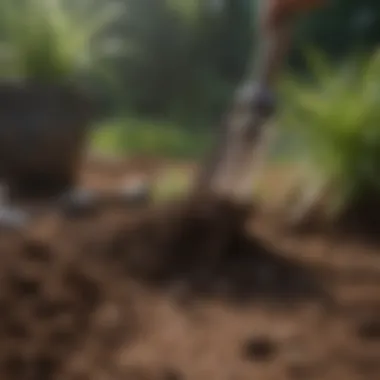Finding the Best Time to Plant Grass Seed


Intro
Timing is everything, especially when it comes to planting grass seed. Many homeowners might think that tossing some seeds onto the soil will yield a lush lawn within a few weeks. However, this approach often leads to disappointment. Understanding the optimal periods for planting grass seed—considering factors like type of grass, local climate, and soil conditions—can make all the difference in achieving that verdant paradise you dream about.
This exploration will delve into the nuances of grass seed planting. From deciphering the telltale signs of seasonal change to the meticulous preparation of soil, every small detail plays a significant role in the success of a lush lawn. As we move ahead, it’s crucial to emphasize that the journey to an admirable garden doesn’t start with the seed but rather with knowledge and planning.
Climate Considerations
The local climate is one of the principal factors that shape the right timing for planting grass seed. Different regions have distinct seasonal rhythms.
For instance, if you live in a warmer area, the best time to sow warm-season grasses, like Bermuda or Zoysia, generally lands between late spring and early summer. The soil temperature plays a vital role here—warm-seed varieties germinate best when the soil reaches around 65°F.
On the flip side, cool-season grasses like Kentucky Bluegrass ought to be seeded in early spring or early fall. These seeds thrive in cooler temperatures and can handle a bit of frost. For instance, waiting until the soil temp is around 50°F is usually ideal for these varieties.
Soil Preparation
Before planting, it’s critical to ensure the soil is in prime condition. Here are some foundational steps you should consider:
- Testing Soil pH: The optimal pH for grass growth typically ranges from 6.0 to 7.0. This not only aids in seed germination but also encourages nutrient uptake.
- Removing Debris: Clear the area of leaves, twigs, or stones that could hinder seed growth.
- Aerating the Soil: Using a garden fork or an aerator may help relieve compaction, which in turn allows roots to grow deeply and access nutrients effectively.
Getting the soil ready is reminiscent of preparing a canvas before painting. If you want a masterpiece, you must begin with a clean and receptive base.
Timing the Planting
Now that the soil is well-prepared, let’s dig into the timing. Here are fundamental points to remember:
- Weather Patterns: Pay attention to the local forecast. Planting just before a rain can help the seeds take root. However, plant too late in the fall, and you risk having the seeds freeze.
- Day Length: The longer days of spring and early summer provide ample sunlight which grass needs to flourish. During these periods, grass grows more vigorously than in the shorter days of autumn.
- Frost Dates: Keep an eye on the last frost date in spring or the first frost of fall. Planting grass seeds too late can yield minimal results if the temperatures tumble abruptly.
In summary, planting grass seed isn’t merely a matter of choice but a blend of astute observation and environmental awareness. By aligning personal gardening practices with seasonal trends and grass types, homeowners can establish the foundation for a rich and enduring lawn. Remember, a little respect for the natural order goes a long way in your gardening endeavors.
Understanding Grass Seed Types
Understanding the various types of grass seed is crucial when it comes to planting and maintaining a lush and healthy lawn. Different varieties thrive in different conditions, making it essential to know which seeds suit your region's climate and your lawn's specific needs. The right selection of grass not only enhances the visual appeal of your yard but also affects factors like drought resistance, pest resilience, and the overall durability of your lawn.
Cool-Season Grasses
Characteristics and Benefits
Cool-season grasses are the stars of the show in northern climates. Their thick blades and deep roots allow them to flourish in the cooler months, typically from late fall to early spring. Grass types like Kentucky Bluegrass, Perennial Ryegrass, and Tall Fescue belong to this category.
One of the key characteristics of cool-season grasses is their ability to grow under lower temperatures, usually thriving between 60-75°F. This makes them particularly advantageous for homeowners in regions that experience cold winters and mild summers. They typically establish quickly in fall, bouncing back with a vigor that can outlast warmer varieties when temperatures dip.
However, one must note that while these grasses perform well in cooler weather, they struggle during the hot summer months. You may find them becoming brown and dormant in scorching heat, especially if water isn’t readily available.
Best Growth Conditions
For cool-season grasses, the best growth typically hinges on a few key elements — moderate temperatures, adequate moisture, and well-aerated soil. Such grasses flourish when planted in spring or early fall, ideally about 6-8 weeks before the first expected frost.
A unique feature of this growth condition is how these grasses can handle soil that is moderately acidic to neutral, often thriving at a pH between 6.0 and 7.0. This adaptability can be seen as an advantage, giving homeowners some leeway when it comes to local soil types. However, not addressing soil issues before planting can lead to a patchy lawn that lacks vitality.
Warm-Season Grasses
Characteristics and Benefits
In contrast, warm-season grasses truly shine when the temperatures soar. Varieties like Bermuda Grass, Zoysia Grass, and Buffalo Grass perform their best in temperatures ranging from 80-95°F. This allows them to establish healthy root systems during the hot summer months.
One remarkable characteristic of warm-season grasses is their drought resistance. Their deep-root systems tap into the moisture below the surface, offering homeowners a robust lawn even during dry spells. Because of this, they are becoming a popular choice in regions that experience long, hot summers. Still, folks should consider that these grasses tend to go dormant during colder periods, often leaving a brown landscape in winter.
Best Growth Conditions
Warm-season grasses favor growth in well-draining, sandy soils that allow for easy root expansion. It's best to plant them in late spring, around the last frost date, providing ample time for their root systems to establish before the summer heat kicks in.
The unique feature here is their love for sunlight; they require full sun exposure of at least 6-8 hours daily to really get going. While this makes them perfect for southern climates, homeowners in shadier areas may find it challenging to achieve ideal growth. Lack of adequate sunlight can hinder their development, making proper site selection key to cultivating a thriving lawn.
"Choosing the right type of grass seed based on your local climate can significantly enhance the durability and beauty of your lawn."
In summary, understanding the differences between cool-season and warm-season grasses can provide significant advantages in planning a vibrant lawn. Each type has its pros and cons, and recognizing what suits your environment and lifestyle is essential for ensuring success.
Climate Considerations
Understanding climate considerations is crucial when it comes to successful grass seed planting. It’s like trying to bake a cake without knowing if you need the oven on or off. The right timing, paired with local weather patterns, influences how well your lawn will establish itself. These considerations include temperatures, precipitation patterns, and even seasonal shifts. It’s not just about throwing seeds on the ground; it’s about knowing the environment your grass will grow in.


Temperature Ranges
Optimal Daytime and Nighttime Temperatures
The role of temperature in grass seed planting can't be overstated. Grass types thrive within specific temperature ranges. Generally, cool-season grasses prefer daytime temperatures between 60°F and 75°F, while warm-season grasses prefer temperatures from 75°F to 90°F during the day.
At night, it’s the drop in temperature that often matters just as much. Cool-season varieties usually need nighttime temps to fall back to between 45°F and 65°F, making it ideal for germination and growth. This precise balance of warmth during the day and coolness at night is beneficial because it encourages strong roots and vibrant growth.
Yet, the downside exists too. High temperatures can lead to stress. When it gets above 85°F for cool-season grasses, germination may stutter. In simpler terms, think of it as trying to run a marathon under the blazing sun without water — it doesn’t end well. So, understanding the specifics of your region's temperatures is vital for successful grass growth.
Frost Dates and Precautions
Frost dates can be the uninvited guests that ruin a well-laid plan for lawn care. Knowing your region's average last frost date in spring and first frost date in fall can save your seeds from chilling—literally. Planting too soon before the last frost can lead to seeds wilting under ice, while delayed planting might mean risking the cold snap as winter approaches.
The typical characteristic of frost warnings is the nip in the air. Understanding when to plant is more than just keeping an eye on the calendar. It is about analyzing micro-climates or local conditions. For some folks living in frost-prone areas, waiting even a week or two beyond the expected dates makes a difference.
When frost is in the forecast, precautions can include covering young grass with burlap or utilizing row covers. These solutions can act as insulation, helping safeguard the vulnerable young plants. Proactive measures may stem the tide of frost damage, but it demands attention and care, much like watching over a fresh batch of cookies.
Precipitation Patterns
Impact of Rainfall on Germination
Water is the lifeblood of any germination process. Grass seeds require adequate moisture to sprout, and rainfall can be a game-changer after planting. Ideal seed germination occurs when the soil remains consistently moist but not soggy. If a deluge rolls in right after planting, the seeds may wash away or, worse, drown in excess water.
Consistent rainfall allows seeds to utilize nutrients already present in the soil. This aspect of rainfall is particularly essential because it not only supports initial germination but also nurtures the development of strong roots as the grass matures. However, too much rain might promote fungal diseases, a situation no homeowner would want hovering over their new lawn.
Drought Conditions
Drought is a double-edged sword when it comes to planting grass seeds. On one hand, dry conditions may delay your planting schedule, while on the other, they can significantly impact the germination rate of newly planted grass. Understanding local drought patterns is necessary to decide whether to wait or adjust plans accordingly.
During drought, soil moisture can evaporate rapidly, and without adequate watering, seeds may remain dormant indefinitely. In these scenarios, the characteristics of drought heighten the stakes. Grass varieties selected for harsher conditions can provide some resilience. But overall, drought conditions demand an effective watering strategy to ensure that the seeds receive enough moisture to thrive.
The unique feature of drought-prone areas often involves implementing xeriscaping principles, encouraging the use of xeric grasses that require minimal water once established. It not only conserves water but can also ease the burden on maintenance down the road.
Remember: Timing your planting around local climate conditions is life blood for your lawn success. Knowledge of these factors can lead to a lush, resilient landscape ready to weather any storm.
Seasonal Planting Guidelines
When it comes to achieving a lush, green lawn, the timing of planting grass seed can’t be overstated. Seasonal planting guidelines provide a roadmap for homeowners who want to optimize growth, cater to specific grass types, and work with their local climate. Understanding the seasons is key to ensuring that the grass germinates successfully and establishes a strong root system. This segment digs deep into spring and fall plantings, revealing their distinct roles and advantages.
Spring Planting
Timing for Effective Growth
Timing is everything. Spring planting typically occurs in the late morning or early afternoon when temperatures start to warm up, usually around late March to early May in many areas. At this juncture, soil temperatures range between 50 and 65 degrees Fahrenheit, which is ideal for most grass types to thrive. This specific timing allows seeds to germinate effectively, benefiting from the longer days and warm moisture brought by melting snow and spring rains.
The notably beneficial aspect of spring planting is that it aligns with nature’s rhythms. As trees begin to bud and flowers bloom, so does your newly planted grass. One unique perk is that the risk of frost diminishes, which can help avoid the potential setbacks of late freezes, which are not uncommon in early planting attempts.
However, a potential downside is that spring can usher in a flurry of weeds vying for resources. Homeowners need to be vigilant, as these pesky plants can siphon nourishment from your young grass.
Soil Preparation Techniques
Before sowing those seeds, soil preparation is paramount. A beautifully prepared lawn sets the stage for your grass to flourish. This involves testing the soil, tilling, and adding organic mater. One important characteristic of soil preparation is its ability to enhance drainage and aeration. When soil is properly aerated, it ensures that roots have enough space to grow and access essential nutrients.
The unique feature here is that well-prepped soil not only influences immediate growth but also sets a strong foundation for future health. Poorly prepared soil can lead to stunted growth and increased vulnerability to diseases.
Consider the advantages of incorporating compost or rotted manure; these organic amendments provide nutrients that synthetic fertilizers might lack, creating a healthy ecosystem for your grass to thrive. Yet, if not done carefully, it could lead to nutrient overload, harming rather than helping.
Fall Planting
Advantages of Fall Planting
Planting in the fall has several merits that can’t be overlooked. The growing conditions in fall, particularly September to October, often yield superior results. One of the key benefits comes from cooler temperatures, which reduce stress on seedlings while allowing them to establish robust root systems before winter sets in. Moreover, with moisture levels from autumn rains, this can lead to a lush green carpet in springtime.
A distinct advantage is that fall planting typically features fewer weeds competing for nutrients compared to spring planting. Homeowners can reap the rewards of a healthier growth cycle without the hassle of intensive weed management early in the season. However, be mindful – this timing might still need your attention on the occasional frost, as these can hinder germination if not addressed.
Timing for Cool-Season Grasses
For cool-season grasses, late summer to early fall is the golden window. Directly before the first frost, which usually occurs between late September and early October, is the most favorable time to plant these grasses. This specific aspect aligns with the natural growth cycle of cool-season varieties, allowing them to thrive under the cooler conditions.
One notable characteristic of this timing is its efficiency. Cool-season grasses will germinate quickly when planted as temperatures drop, taking full advantage of fall moisture and ensuring that grass can establish before the cold grips the ground. They generally grow best in temps from 60 to 75 degrees Fahrenheit.


The unique advantage here is that as the weather warms up in spring, these grasses begin to flourish while the competition is limited, allowing you to maintain a fuller, healthier lawn. However, the window is tight; late planting risks poor establishment and outcomes can vary, depending upon seasonal conditions.
In summation, understanding and adhering to seasonal planting guidelines can significantly impact lawn success. The choice between spring and fall planting needs careful consideration based on your specific grass type and local climate conditions.
Preparing for Seed Planting
Getting ready for planting grass seed isn’t just a side note; it’s the very foundation of a thriving lawn. Without proper preparation, all the right timing and right conditions might not cut it. Just like trying to bake a cake without sifting the flour or measuring the sugar properly—there's a good chance you'll end up with a flop, not a feast. Let’s dive into how you can set the stage for success in your lawn.
Soil Testing
Assessing Soil Health
To understand your garden's well-being, soil testing is an essential step. You need to know what’s going on beneath the surface. Healthy soil is like a well-balanced diet; it’s got the right nutrients that grass needs to grow strong and green. Typically, a soil test will reveal the nutrient content, texture, and structure of your soil.
A standout feature of soil testing is its ability to pinpoint issues before they escalate into bigger problems. Think of it like getting a health check-up; catching a potential issue early can save you a lot of heartache down the road. In this article, highlighting soil health will guide homeowners to make informed decisions, ensuring they lay the groundwork for a robust lawn.
Adjusting pH Levels
The pH level of your soil plays a crucial role in grass growth. If your soil can be likened to a classroom, pH balance keeps the learning environment just right. Grasses generally prefer a slightly acidic to neutral soil (around 6 to 7 pH). If the pH is off, certain nutrients can become locked up, making it hard for your grass to absorb them. Adjusting pH levels to suit your grass type creates conditions that promote ideal growth.
By using lime to raise pH or sulfur to lower it, you create a more hospitable environment for your seeds. This level of precision is where many homeowners can get tripped up—overlooking it can lead to a lackluster lawn, diminishing the efforts you’ve already put in.
Soil Amendments
Types of Amendments
Once you've tested your soil, you might find that it needs some help. Soil amendments come in various varieties—organic compost, peat moss, or even synthetic fertilizers. Each type can improve soil structure, nutrient availability, and water retention, but they serve different purposes.
For instance, compost adds beneficial microorganisms and nutrients, while peat moss can enhance moisture retention. It's important to choose the right amendment based on your soil test results. Too much of the wrong type can do more harm than good, making a solid understanding of your soil's specific needs essential.
Benefits of Organic Matter
Organic matter, such as compost or well-rotted manure, holds a special place in gardening lore. Its richness in nutrients improves soil health by enhancing its structure and water-holding capacity. This is particularly beneficial for sandy soils that drain too quickly and clay soils that retain too much water.
Not only does incorporating organic matter enrich the soil, but it also supports a thriving ecosystem by fostering beneficial microorganisms. It's worth noting, though, that it takes time for organic matter to break down and integrate into the soil, so patience is key.
Tilling the Soil
Methods for Tilling
Tilling is often the last step before planting. It’s about breaking up compacted soil and ensuring good seed-to-soil contact. You can choose from various methods—manual tilling with a spade or using a rototiller. Each method has its pros and cons.
Manual tilling gives you more control and is less disruptive; however, it can be labor-intensive. In contrast, rototillers can cover large areas quickly but may disturb soil layers more than desired. Understand the nature of your soil and the scale of your project before deciding on a method; finding the right fit for your project will lead to a better planting outcome.
Importance of Soil Aeration
Aeration is a conversation that often gets overlooked, but it plays a critical role in preparing for grass seed. Soil suffers from compaction over time, limiting oxygen and water from reaching the roots. Aerating the soil creates tiny holes, allowing vital resources to penetrate deeper, facilitating healthier root growth.
Highlighting soil aeration shows how proactive intervention supports long-term investment in lawn health. It can't be underestimated. While it requires effort—whether with a manual aerator or an aeration machine—the benefits of improved drainage and root development make it well worth it as part of your preparation routine.
Planting Techniques
When delving into the intricacies of establishing a flourishing lawn, the method of planting grass seed stands out as a vital consideration. The way in which grass seed is sown influences not just the speed of establishment, but also long-term health and resilience of the grass. Proper planting techniques ensure that seeds are positioned to maximize their chances of germination, resulting in a lush, appealing landscape.
Broadcasting vs. Sodding
Comparative Analysis
In the realm of grass planting techniques, broadcasting and sodding represent two distinct approaches, each with unique implications for both the grass’s growth and the effort required by the gardener. Broadcasting, a sowing method where seeds are scattered evenly over the soil, is well-known for its simplicity and cost-effectiveness. This technique is particularly effective for large areas where uniform coverage is paramount. It allows for an expansive reach, ensuring that grass varieties can fill in a bare patch.
Sodding, on the other hand, involves laying down pre-grown grass sections, effectively giving an instant lawn. While it demands a more significant financial investment, the immediate aesthetic benefits often outweigh the costs for homeowners seeking a quick transformation.
Choosing between these two methods often boils down to specific goals—whether patience is an option or instant gratification is more aligned with the vision for the lawn.
Pros and Cons of Each Method
When weighing the pros and cons of broadcasting and sodding, the differences become clearer.
Pros of Broadcasting:
- Cost-effective: A fraction of the price of sodding, meaning more funds can be allocated elsewhere in the gardening project.
- Flexible Timing: Seeds can be sown during more favorable conditions without the constraints of moving and laying sod.


Cons of Broadcasting:
- Longer Establishment Time: Patience is required, as seeds need time to germinate and grow.
- Susceptibility to Weeds: Seeds might face competition from weeds before they establish a foothold in the soil.
Pros of Sodding:
- Instant Results: A well-laid sod can transform an area almost overnight, providing a finished look swiftly.
- Less Competition: Established sod generally holds up better against weeds than newly sown seeds.
Cons of Sodding:
- Higher Cost: The price point can be prohibitive for some homeowners, especially for large plots.
- Limited Selection of Grasses: Not every type of grass is available as sod, potentially limiting the choice of aesthetics or suitability.
Seed Coverage and Depth
Guidelines for Seed Placement
Adequate seed placement isn’t just about scattering seeds willy-nilly across the soil surface. This phase is crucial and can significantly affect germination success. Grass seeds must be positioned at the ideal depth, typically about 1/8 to 1/4 inch for most species. Deeper placement can hinder germination as the seeds might struggle to break through soil, while too shallow might expose them to drying out.
An organized approach often pays dividends. A light raking can help ensure even coverage, while rolling the area after can promote soil contact, enhancing moisture retention and germination rates.
Watering Techniques Post-Planting
Once the seeds have been sown, proper watering techniques become essential. A common misconception is that a drenched lawn fosters rapid growth. In reality, seeds need consistent moisture but not over-saturation.
Key Points for Effective Watering:
- Frequency: Instead of large, infrequent watering, focus on lighter sessions multiple times a day, especially in the initial weeks.
- Timing: Early morning is often the best time to water, allowing moisture to seep deep into the soil while reducing evaporation loss.
- Observation: Adjust the watering schedule based on weather conditions. In rainy periods, reduce the frequency and allow for natural moisture.
Maintaining a clear understanding of these post-planting techniques not only promotes effective grass establishment but also nurtures a long-lasting and healthy lawn.
Post-Planting Care
Taking care of your newly planted grass seed is just as important as the planting process itself. While optimal timing for seeding sets the foundation, post-planting care ensures that your grass comes up strong and vibrant. This section outlines the key elements of watering, fertilization, and pest management that collectively contribute to the successful establishment of your lawn. Neglecting these aspects could lead to a lackluster result, so paying attention to these details is paramount.
Watering Schedule
Frequency and Duration
Getting the watering schedule right can make or break your grass seed's future. In the early days after planting, the soil must stay consistently moist for proper germination. Watering daily for short durations is a common approach. This helps prevent the soil from drying out. A key characteristic of this routine is how it encourages seed germination without drowning it.
When watering, aim to soak the top inch of soil, allowing roots to develop strength. A unique feature here is that as your grass begins to grow more robustly, the frequency should decrease. For instance, shifting to every other day may be beneficial as the grass establishes itself. It's common to find that once a more established root system is created, watering can be spread out further to every three days. This method not only satisfies the grass's needs but also saves water.
Avoiding Overwatering
While watering is essential, going overboard can lead to overwatering. This term refers to the too-frequent application of water that can suffocate the grass roots and encourage fungal diseases. A hallmark of this challenge is how some might perceive it as a simple case of trying to be diligent. Yet, overwatering often leads to root rot, affecting the lawn’s overall health.
Monitoring the soil moisture is a beneficial approach here. Stick your finger into the soil; if it feels damp an inch down, it's time to skip watering. One unique aspect is that while it requires initial attention, once established, a lawn usually only needs watering once or twice a week, depending on the weather. By being cautious with watering, you're setting your grass up for sustainable growth rather than struggle.
Fertilization Practices
Types of Fertilizers
When it comes to fertilizers, you have various types. Organic and synthetic are two of the primary categories. Organic fertilizers, like compost or bone meal, release nutrients gradually, promoting healthy growth without overwhelming the grass. This slow-release quality is indeed a preferred choice for many since it nourishes the grass steadily over time.
On the other hand, synthetic fertilizers provide a quick boost, ideal for immediate benefits. They contain higher concentrations of nutrients, which can lead to rapid growth. The downside is the risk of "burning" the grass if applied too heavily. Thus, understanding which type suits your specific situation is vital. The unique feature of employing various fertilizers allows for a customized nutrition regime that aligns with the specific needs of your grass.
Timing for Application
The correct timing for applying fertilizer is equally pivotal. When to commence fertilization depends on whether you’re nurturing cool-season or warm-season grasses. A common recommendation is to apply fertilizers shortly after planting and again at the point when the grass begins to actively grow. Timing your application to coincide with growth phases is a wise move, as it allows the grass to effectively utilize the nutrients.
Furthermore, checking soil nutrients through testing can inform when to apply fertilizer. The advantage here lies in tailored care, avoiding the pitfalls of guesswork or premature application. This method nurtures a healthy lawn ecosystem and lowers the overall risk of nutrient leeching and waste, fostering a robust lawn over time.
Weed and Pest Management
Identifying Common Weeds
Addressing weed growth is another crucial aspect of post-planting care. Identifying common weeds spotted in your yard is essential. Weeds like chickweed or crabgrass can easily outcompete young grass for sunlight and nutrients. Recognizing them early allows you to act before they establish a foothold. This is where vigilance comes into play – keep an eye out for new, undesired growth as your grass seed begins to germinate.
The key characteristic of having knowledge about local weeds is that it allows you to plan your lawn care proactively. A unique feature associated with this awareness is that once you're better equipped to identify troublesome weeds, pre-emergent herbicides can be employed in advance to prevent germination.
Integrated Pest Management Techniques
Last but not least, protecting your grass from pests requires strategic planning. Integrated Pest Management (IPM) techniques stand out as an effective approach. This concept revolves around using a combination of biological controls, cultural practices, and judicious use of pesticides only when necessary. Think of IPM as a layered defense – it’s about preventing and managing pests on multiple fronts.
A hallmark of these techniques is their eco-friendly nature. By integrating practices like crop rotation, habitat manipulation, and natural pest predators, you can create a balanced ecosystem. This method minimizes harm to beneficial insects and the surrounding environment. One unique feature about IPM is that it emphasizes long-term solutions rather than quick fixes, allowing for a healthy lawn that thrives without undue interference.
In essence, post-planting care encompasses a range of practices that ensure your grass seed not only germinates but flourishes. By paying attention to watering, fertilization, and pest management, you can help establish a resilient and lush lawn that withstands the test of time.



